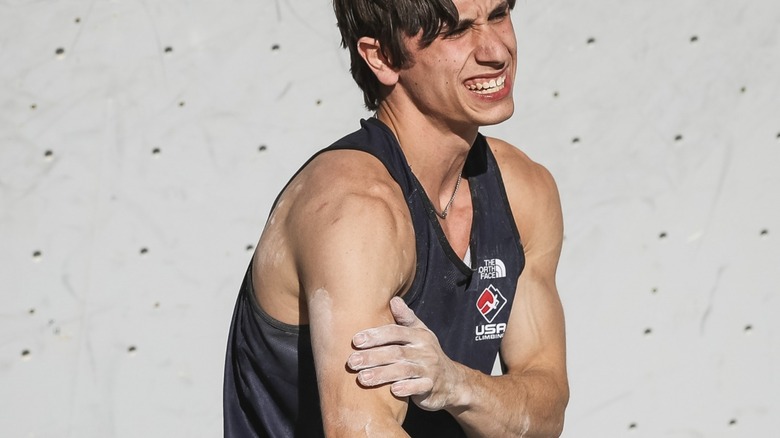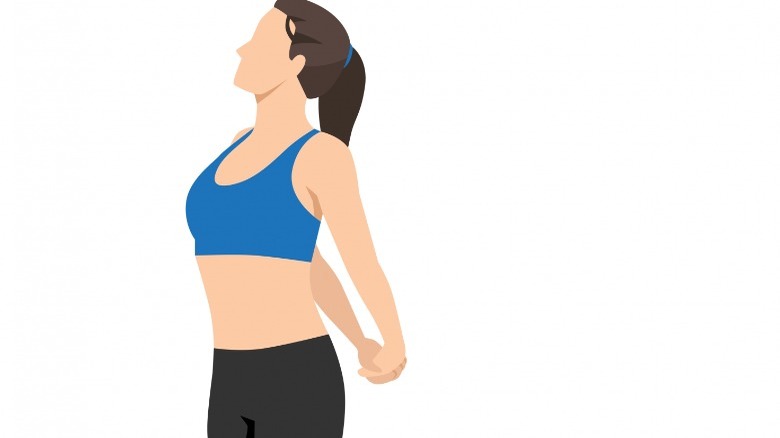The Best Bicep Stretches After An Intense Arm Workout
If you are serious about your fitness, then you likely put a special priority on working out. In particular, you might like to work out your arms. Arm exercises like curls, chaturanga, and rows can help build strength, grip, stamina, and of course, muscle mass. But there's more to fitness than gains. If you want to be the best version of yourself, then you might want to consider developing more flexibility by stretching.
According to Mayo Clinic, stretching can improve flexibility, which can lead to better performance during workouts, boost blood flow, lower risk of injury, and increase the range of motion in joints. While stretching once may not improve your overall flexibility, sticking to a consistent routine can loosen those tight muscles (via Harvard Health Publishing). Try to shoot for a stretching routine where you stretch for around 3 to 4 days a week. Here's a list of bicep stretches to incorporate into your routine after an intense arm workout.
Standing bicep stretch
The standing bicep stretch is a great bonus stretch because it also targets the chest and shoulders (per Healthline). Before you get into the stretch, know that you can hold the position for up to 1 minute and repeat 1 to 3 times, so make sure the position feels comfortable and does not cause any intense pain. Once you are ready to start the stretch, make sure you are in an area that gives you enough space to extend your arms behind your back. You can do a quick test run by extending your arms behind your back to check to see if you have enough space.
To perform the standing bicep stretch, first begin in a standing position and slightly bend your knees. Next, place your arms behind your back and interlace your fingers near the bottom of your spine so that your knuckles face your back. Then extend your arms and straighten them. Make sure to keep your palms facing away from your body while you raise your arms towards the ceiling.
Doorway bicep stretch
This stretch simply requires your body and an open doorway. It is also a bonus stretch, because in addition to the bicep, the stretch also targets parts of the deltoid and the pectoral muscles (per Exercise Prescription). Be careful not to lock out your arm or overextend it during this stretch, since the pressure may feel intense.
To start the stretch, find a wall or a doorway and stand one arm's length away from the object. Make sure that your stance is natural and that your feet are about the same distance apart as your shoulders. Then, place the palm of your hand on the wall and make sure that it is about shoulder height. This will be the target arm for the stretch. Slowly reposition your body by turning it away from the target arm. At this point, you should start to feel the stretch. Again, make sure that you do not lock out the arm or over-extend it. You can hold the stretch for up to 30 seconds on each arm.
Standing wring with a towel
For this exercise you do not actually need a towel. Instead, the concept of wringing out a wet towel is a metaphor for this stretch because you will essentially wring out your arms, neck, and shoulders like a towel (per Set For Set). This stretch can be quite sensational, so be aware that you might feel a running stretch through the target muscle groups. However, the stretch should not cause any pain. Be cautious of how fully you extend the stretch.
To start, make sure that you have enough space to extend both of your arms fully out to your side. Then extend both of your arms out to your sides, with one palm facing the floor and the other palm facing up towards the ceiling. When done correctly, your body should make a "T" shape. Next, rotate your head to face the side where your palm is facing up. In one fluid motion, rotate your head to the other side and switch positions with your arms, placing the opposite palm — the one you are rotating your head towards — up towards the ceiling while you rotate the other palm down towards the floor.
Hanging bicep stretch
Whether you have one at home or the gym this exercise requires an overhead bar. While it may be tempting to get creative and use a branch or some other object, these could break and actually lead to injury. If you don't have one at home or don't have a gym membership, some parks have exercise stations that include a variety of overhead bars. There's a lot of room for modification in this exercise, so don't worry if the overhead bar you use is too close to the ground or too far above.
For starters, the simplest way to visualize this stretch is to imagine the beginner stage for a pull-up (via Nutritioneering). To perform the stretch, simply grab the overhead bar with both hands and let your body hang down, your feet may or may not touch the ground. A modification for this stretch works great when your feet touch the ground. While keeping both feet on the ground, grab the bar with one arm and adjust the amount of weight you press into the ground to increase or decrease the stretch.
Seated chair bicep stretch
For this stretch, you will need a chair without a large back support, like a barstool or a dining chair (per Shoulder Pain Explained). Notably, you will hold this bicep stretch for up to 30 seconds and repeat it 3 times.
Once you are sitting in the upright position, place your arms out to the side of your body around your shoulder height and rotate your palms to face up towards the ceiling. Then steadily bring your arms back to increase the stretch. Be sure to remain in an upright position and do not over arch your back, which may happen if you do not isolate the arms in the movement.
There are some variations for this stretch too. You can perform the stretch while standing up, which helps if you are on the go and do not have a chair nearby. You can also modify the stretch by rotating your thumbs to face the floor.






